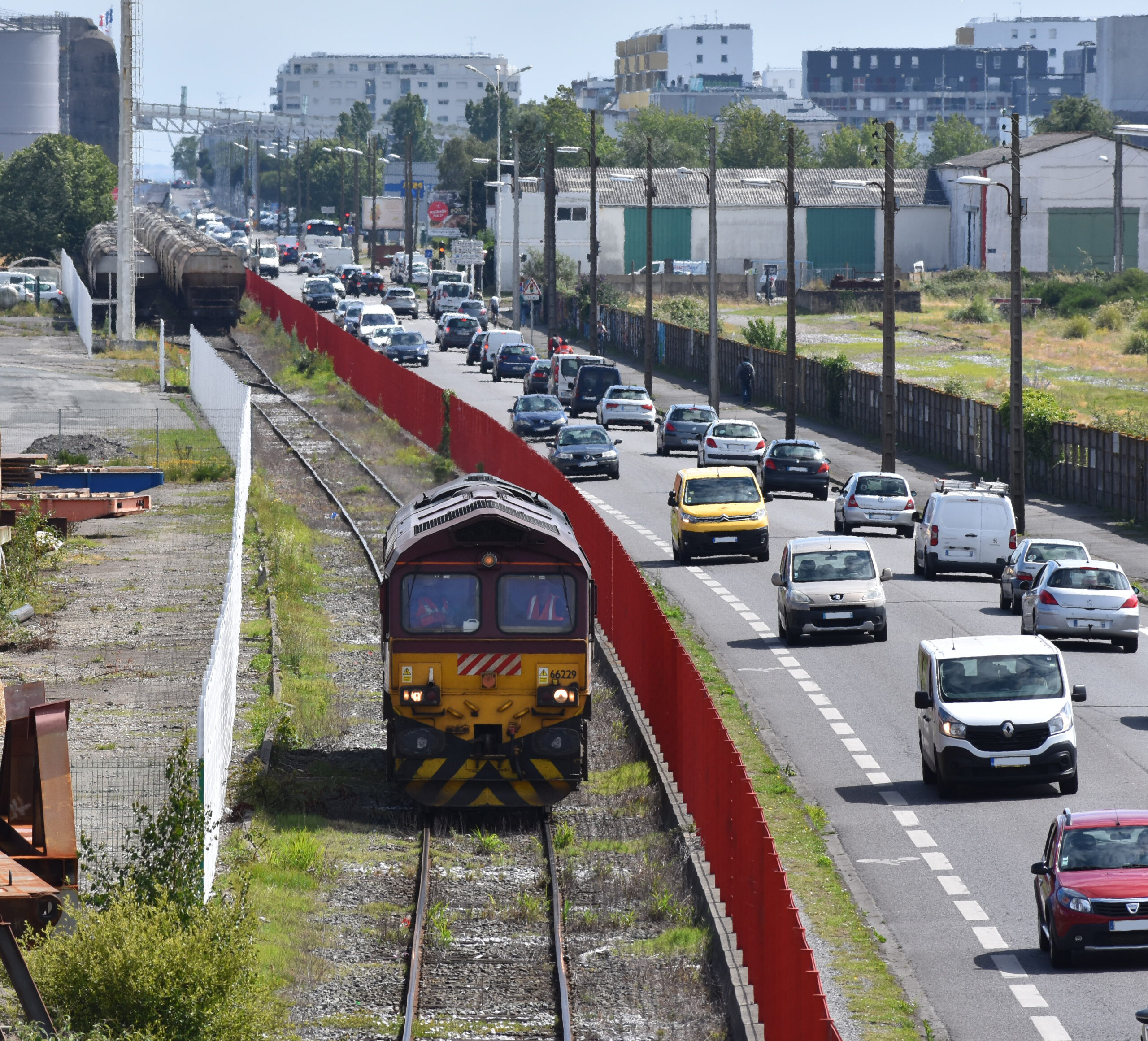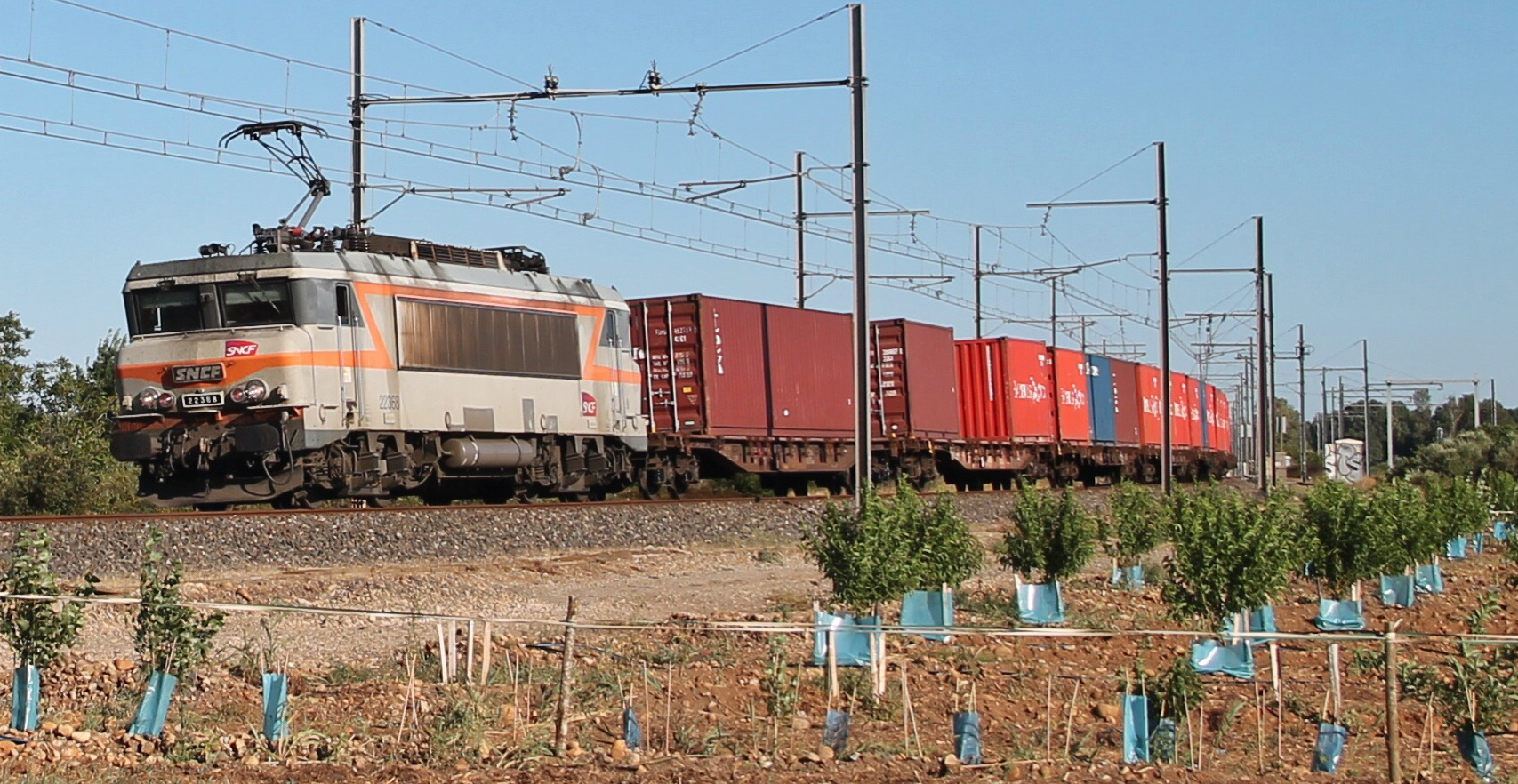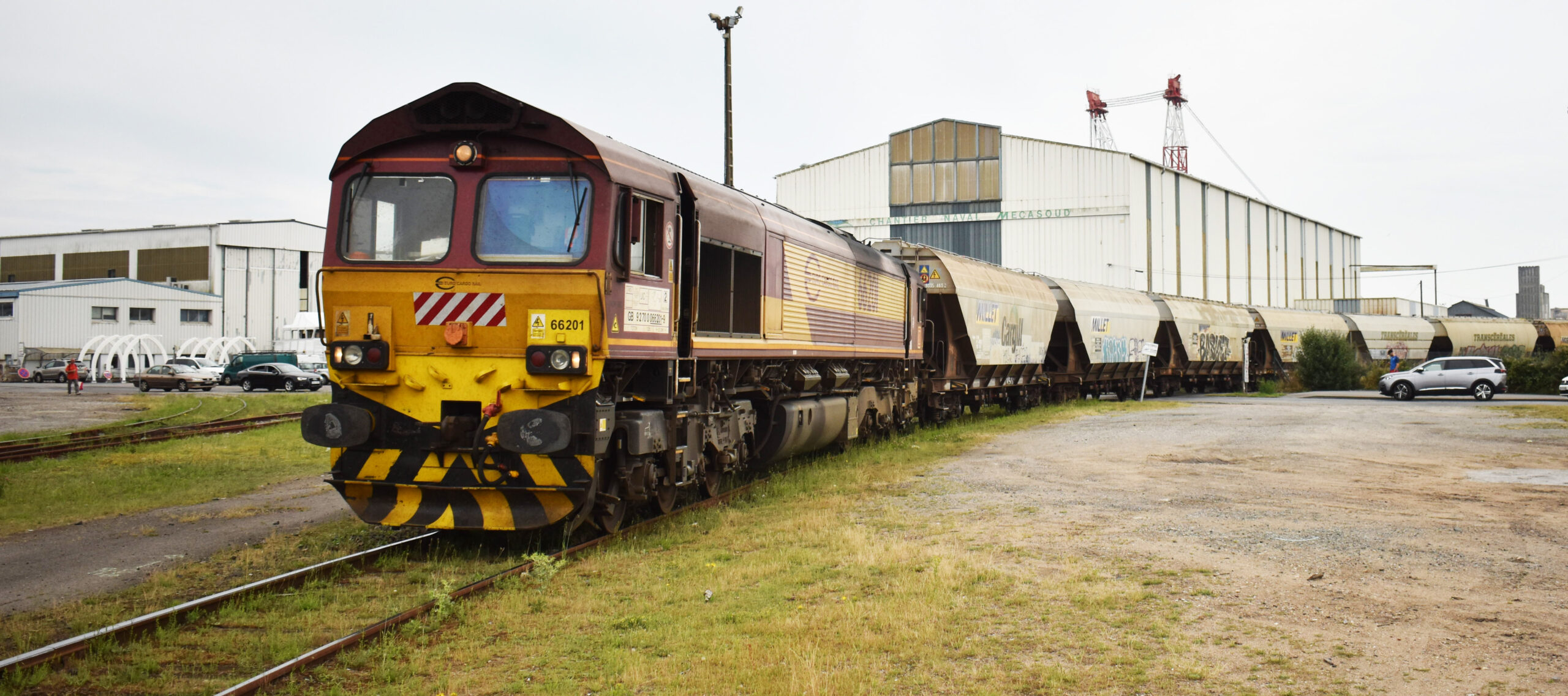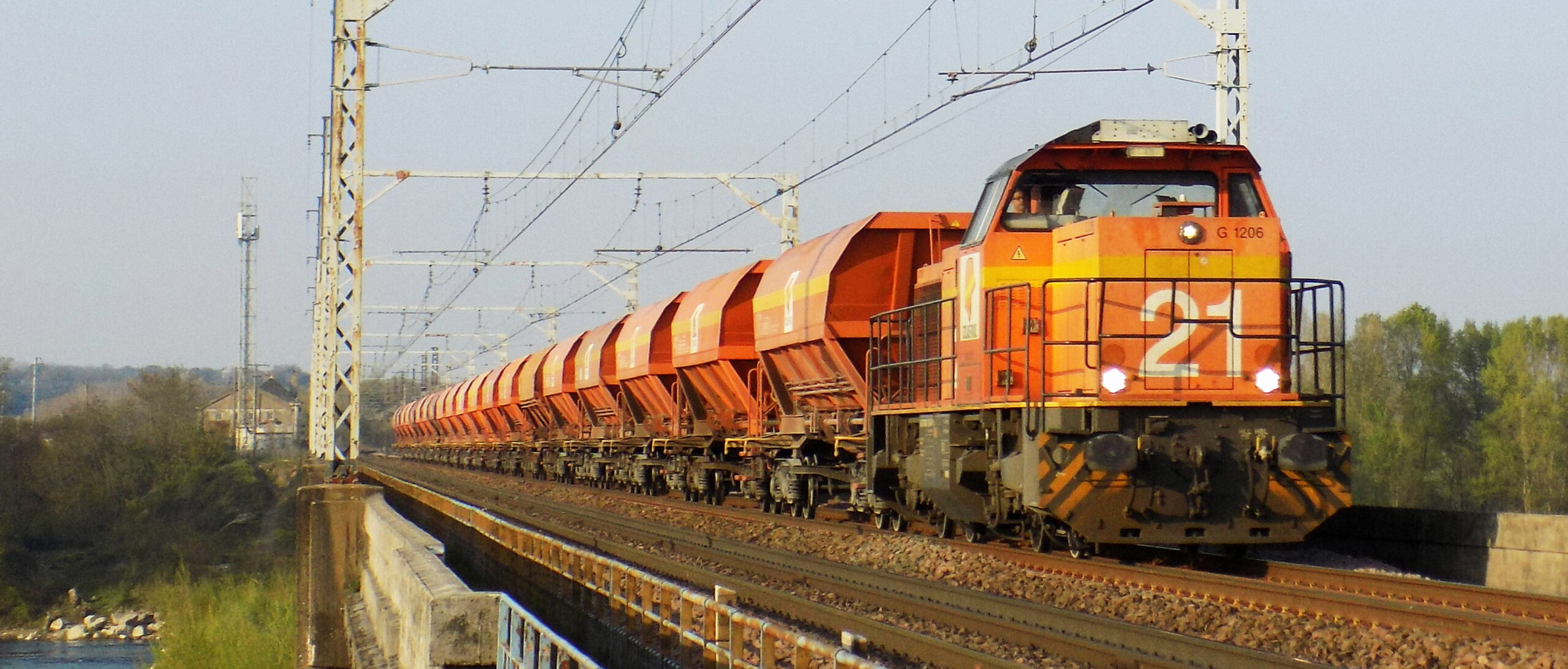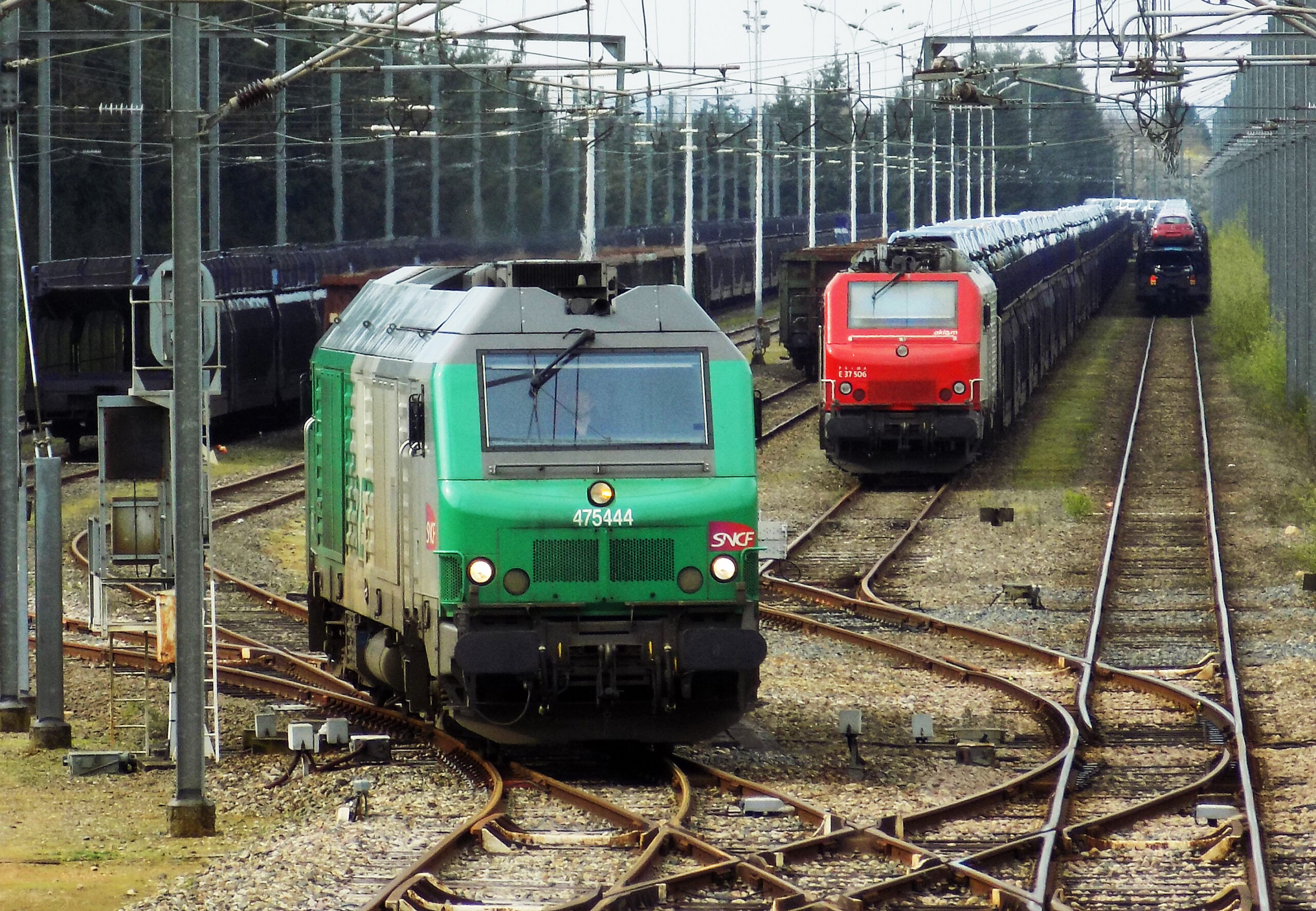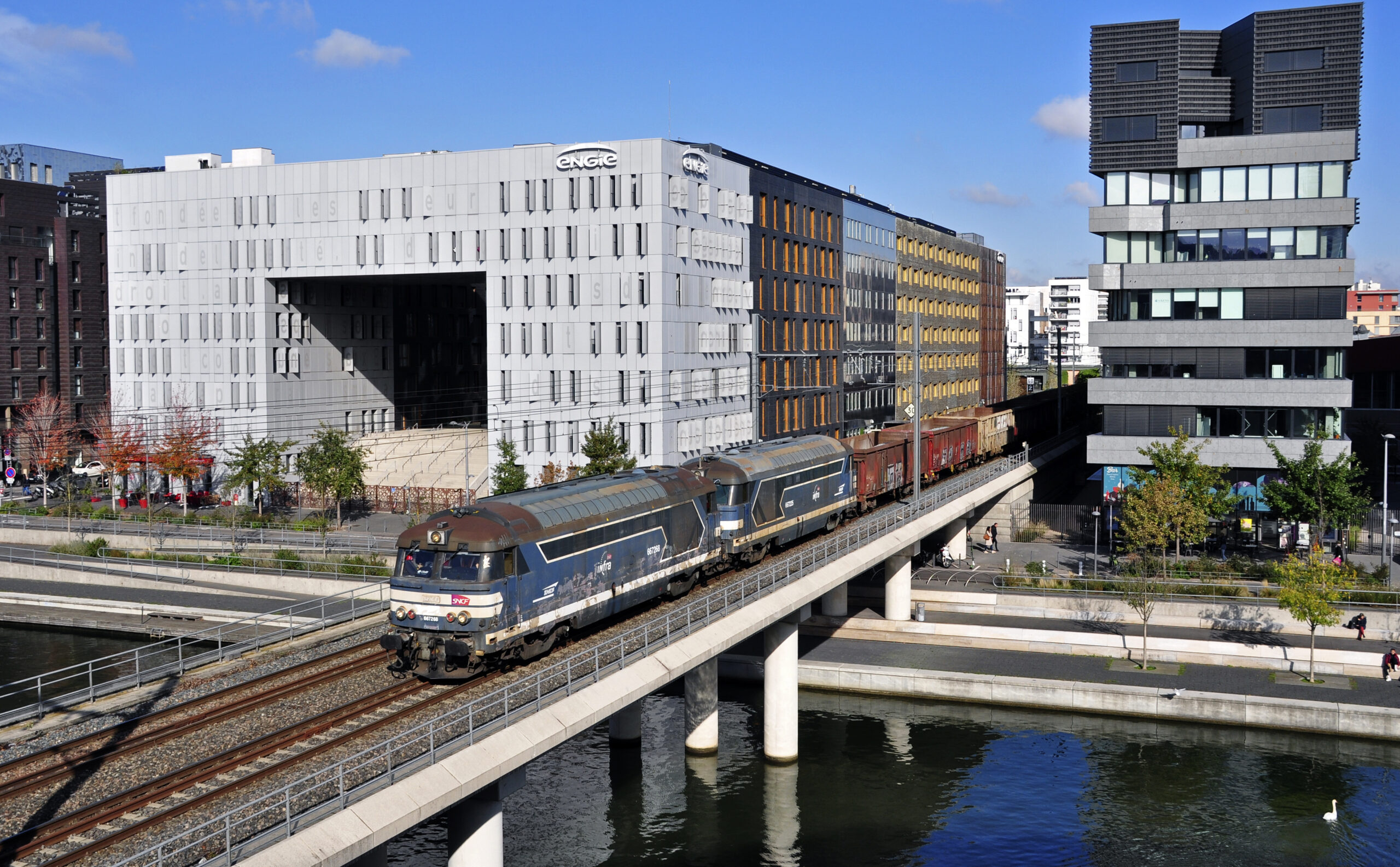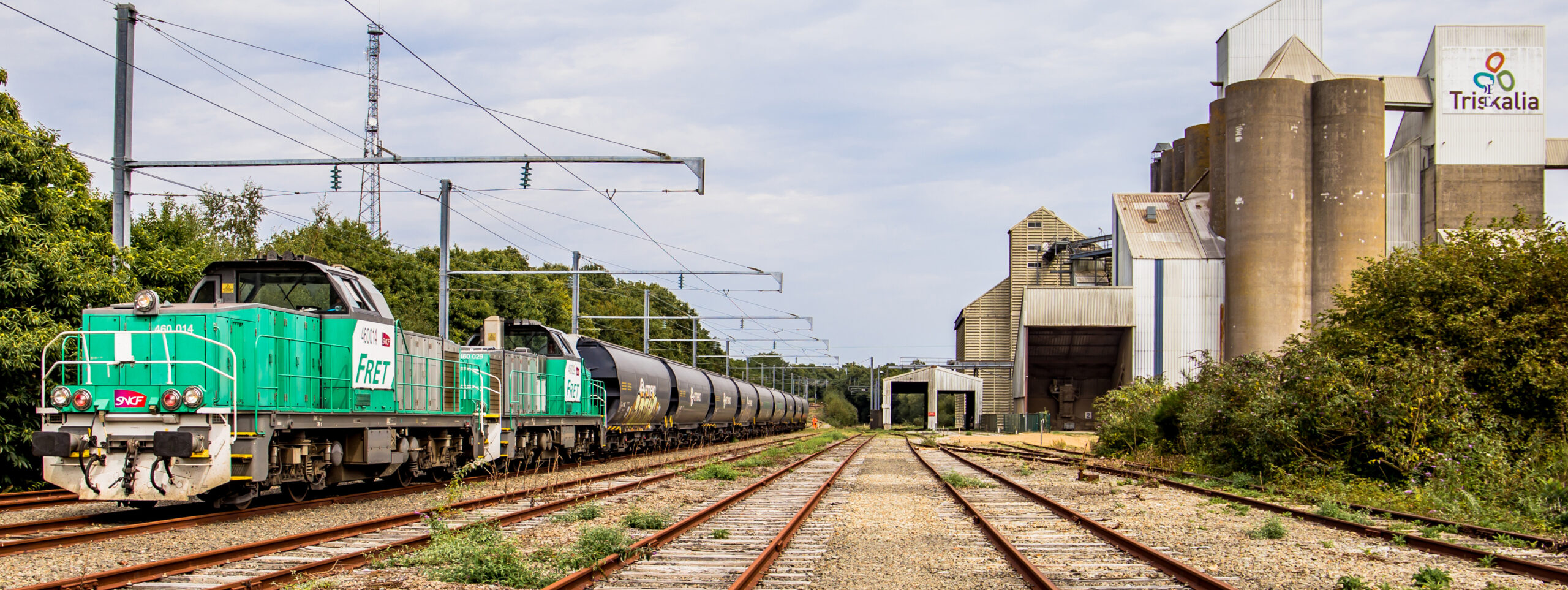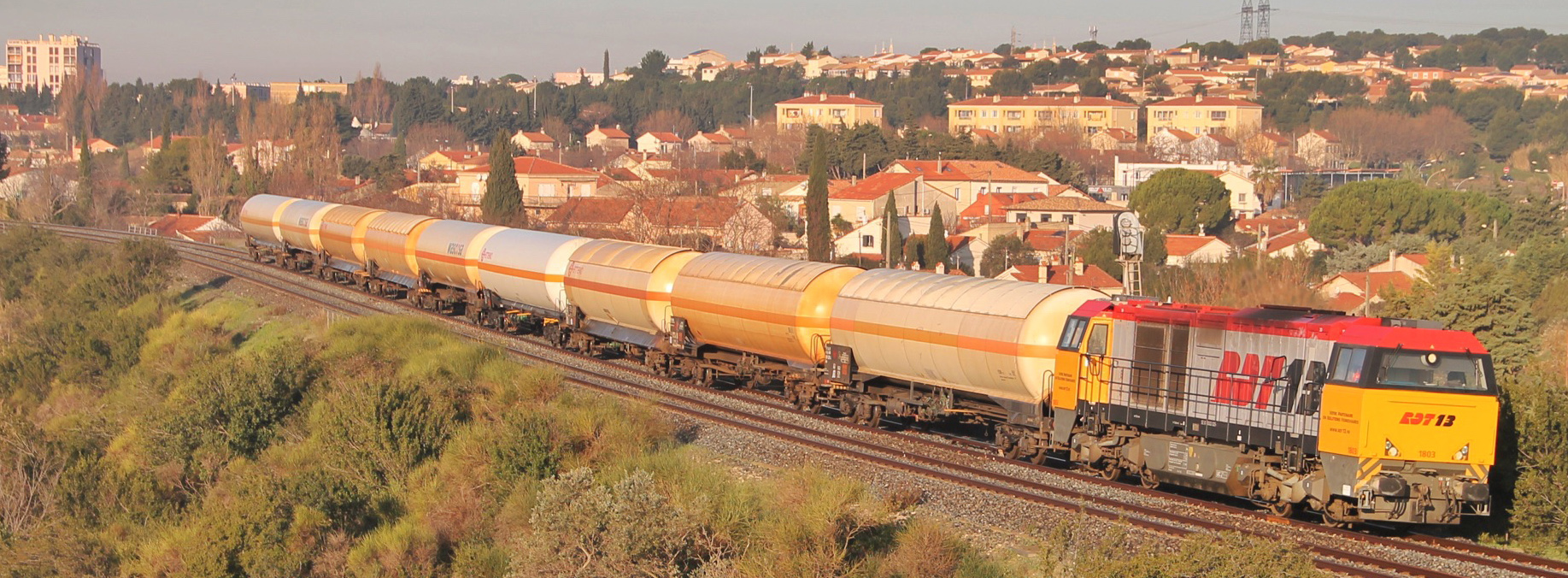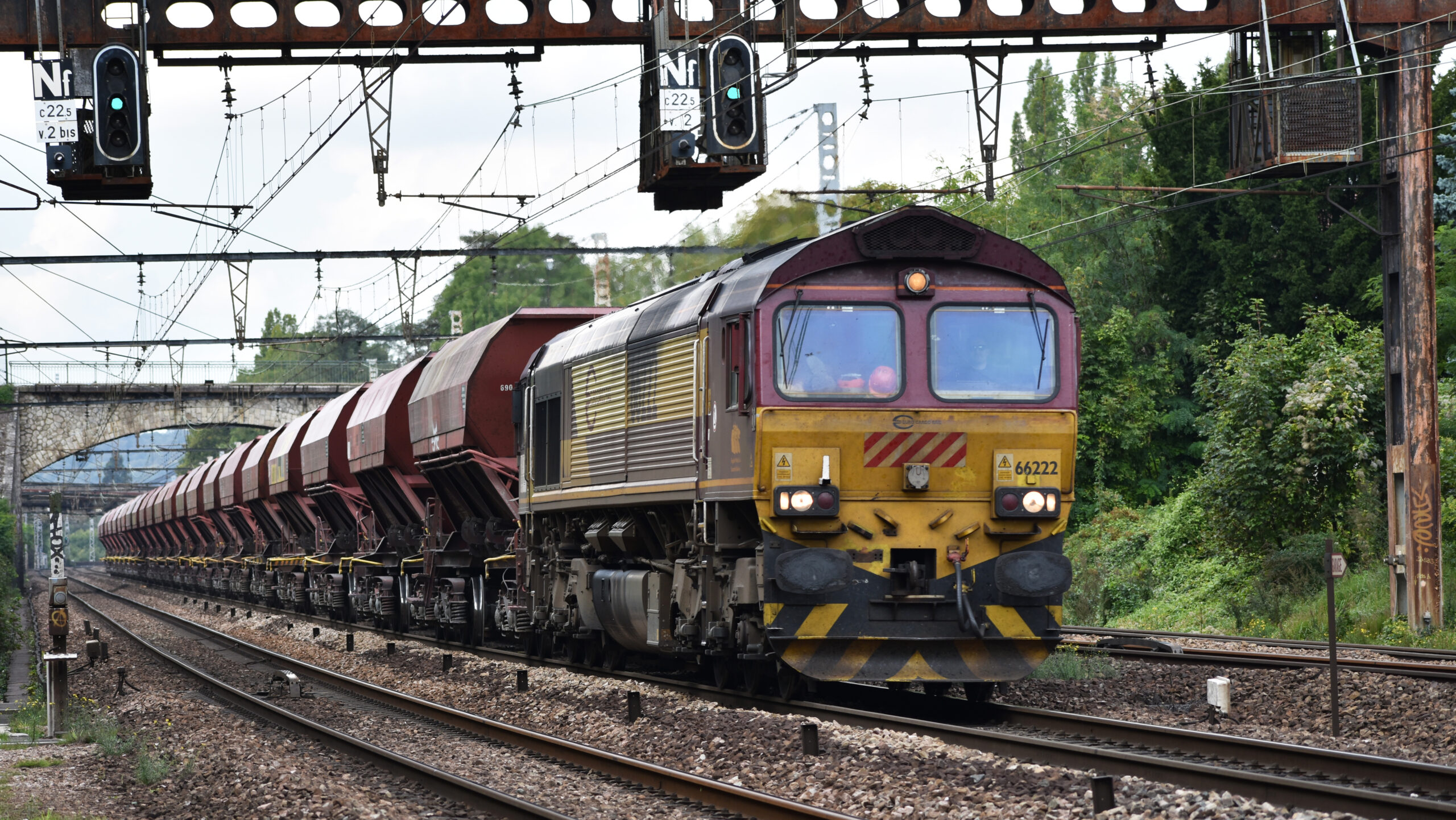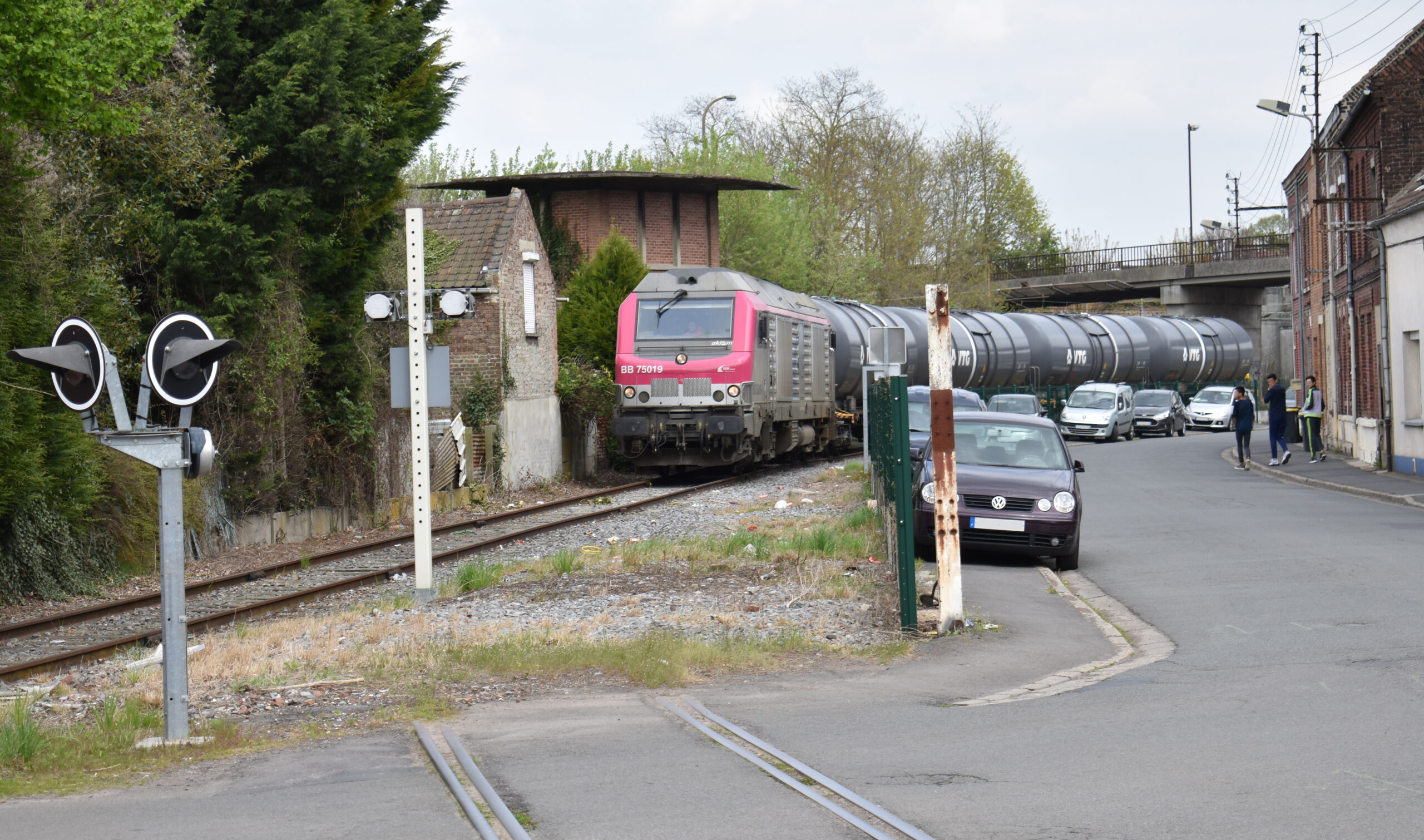Railweb Reports
Rail freight: Is France waking up?
Posted by George Raymond on February 1, 2020
One word has dominated French rail freight in recent weeks and indeed years: strikes. They have been spawned by new laws affecting workers’ job security, retirement age and pensions. Less noticed in late 2019 was another law that pushes the French government to strengthen rail freight’s role in the logistic system underlying the country’s economy. A November conference examined difficulties, innovations and signs of progress in French rail freight.
INSEE statistics show that rail freight’s market share in France declined from 26.6% in 1984 to a historic low of 8.4% in 2010, then ranged between 9.3% and 10.2% until hitting another low of 8.7% in 2018. This reflects the decline of heavy industry but also neglect of rail freight by successive French governments. On 19 November 2019, French lawmakers instructed the current government to develop, by the end of 2020, a strategy for rail freight. Cynics fear just another report. But France’s focus on rail freight is becoming clearer. A day later, on 20 November, an annual conference next to Paris in Levallois revisited the basic needs of customers to which rail freight must respond.
Deutsche Bahn subsidiary Euro Cargo Rail at the Cargill plant in the port of Saint-Nazaire on 19 June 2019. © Jonathan Guiho
Speakers also addressed problems and progress in French rail infrastructure, both on main lines and the secondary tracks and lines that feed them. New measures aim to strengthen both SNCF’s historical freight unit and the 20 or so other train operators that have entered the French rail freight market over the last decade. Services that transport containers, truck trailers, individual wagons and blocks of wagons are all parts of the puzzle. Rail freight’s return to relevance depends both on targeted public support for infrastructure and operations and on innovations ranging from energy sources for locomotives and wagon-brake monitoring to e-learning for staff.
Contents
| Starting with the customers | |
| French public policy | |
| French rail infrastructure | |
| Train operating companies | |
| Rail freight operations | |
| Innovation in French rail freight |
Starting with the customers
Rail freight’s technical, organisational and institutional complexity sometimes seems to distract rail actors from their customers. Several speakers corrected this.
Volume and market share
Trends in both market share and absolute traffic volumes offer a sobering look at what shippers think of French rail freight services.
SNCF Réseau operates the infrastructure of France’s national railway network. Jean-Pierre Orus, of the company’s commercial department, said French rail volume dropped to 32 million tonnes in 2018 from 34 a year earlier. Olivier Deprez of the train operators’ association AFRA, and CEO of train operator Lineas, said that in 2018, the French rail freight sector saw 36 strike days. [GR: These mostly fell during the on-and-off strike in the second quarter of 2018.] Mr Deprez said that volumes were stagnant not just for conventional rail, but also for combined transport, which is more worrisome because shifting freight from trucks to combined transport is easier.
Rail freight’s 8.7% tonne-km share in France in 2018 was the worst in modern times except for 2010. [GR: In the then-28 countries of the EU, rail’s 2018 share was 17.3%.] Mr Deprez asked the audience who had done concrete deals to take traffic from trucks in the past year. Just three people raised their hands. The objective in 2012 had been to increase French freight rail traffic by 2017 by 25%, he said. In fact, it dropped 8%.
Jacques Chauvineau is president of the association Objectif OFP, which promotes local freight operators. He called rail’s 9% share of French freight “not right”. France risks sinking into a situation where everything moves by truck. Increases in rail freight need to be substantial, not incremental, to take advantage of rail’s scale economies. Better rail service will help truck companies by facilitating economic growth.
Not just rail freight, rail logistics
Mr Chauvineau said that France is in a crisis that is not limited to rail freight. Instead of rail freight, actors must think in terms of rail logistics. France can’t be a leading country without logistics, and logistics needs rail. Pascal Boeuf of the Solvay chemical group noted that the French prime minister and former Le Havre mayor Édouard Philippe wants the performance of logistics to support industry.
Combined-transport operator and SNCF group subsidiary Naviland Cargo between Istres and Miramas on its voyage from Fos, next to Marseille, to Bordeaux in the late afternoon of 13 July 2017. © Elise V
French parliament member (MP) Jean-Marc Zulési said that rail must be part of supply logistics. France must develop multi-modal infrastructure offering fast transfers to final clients who want fast delivery. Sylvie Charles, general director for rail and multimodal transport at SNCF Logistics, pointed out that today’s just-in-time economy is open to the world and is thus the opposite of the massified flows of the 20th Century’s heavy industry.
Focussing on international traffic – and on French regions
The fate of rail freight in Europe heavily depends in public policies whose focus, though guided by European law, is often quite domestic. This is reflected in the focus of rail freight conferences, including the annual Levallois conference. But some speakers looked beyond France’s borders.
Gottfried Eymer is CEO of Euro Cargo Rail, the French rail freight unit of Deutsche Bahn. He pointed out that trains must stop at intra-European borders for brake checks and – at French borders – to add/remove French rear lanterns. Trucks do not make such stops.
Mickael Le Ray, rail traction manager of Total Petrochemicals and Refining, said that his company works with 15 train operators in three countries, mostly to run unit trains, and has 6000 wagons. MP Jean-Marc Zulési said that French railways must focus on international traffic and on winning it from trucks. Solvay’s Mr Boeuf said that chemicals often travel long distances, which makes international rail particularly important.
Mr Eymer looked at the main Rhine Valley rail route. In case of a problem on it, north-south trains can run through eastern France. [GR: A high-profile example was the seven-week Rastatt blockage in 2017.] Although these French routes still lack the European standard P400 clearance for rail rolling stock, Mr Eymer said, the trains that do use them reduce truck traffic and CO2 and increase SNCF Réseau’s revenues.
Mr Chauvineau of Objectif OFP said that French railway actors need to consider international traffic but also how to better anchor rail services in French regions.
Ports and their hinterland connections
French MP Jean-Marc Zulési said that actors should focus particularly on ports and their connection to logistics platforms. Philippe Guillard of the port of La Rochelle called a good quality link between port and rails in hinterland essential. Alexis Degouy, executive director of the French transport and logistic employers’ association (TLF), pointed to work to simplify border checks at the ports of Le Havre and Dunkirk.
Deutsche Bahn subsidiary Euro Cargo Rail at the port of Saint-Nazaire on 25 July 2019. © Jonathan Guiho
One of rail’s key customers: the chemical industry
Solvay’s Pascal Boeuf, who is also in the logistics committee of the association France Chemie, said that with its annual turnover of €75 billion, Solvay is the number 8 chemical maker in the world and number 2 in Europe. The company spends €7 to 8 billion on logistics a year. Rail is important to Solvay and even a requirement for some dangerous chemicals.
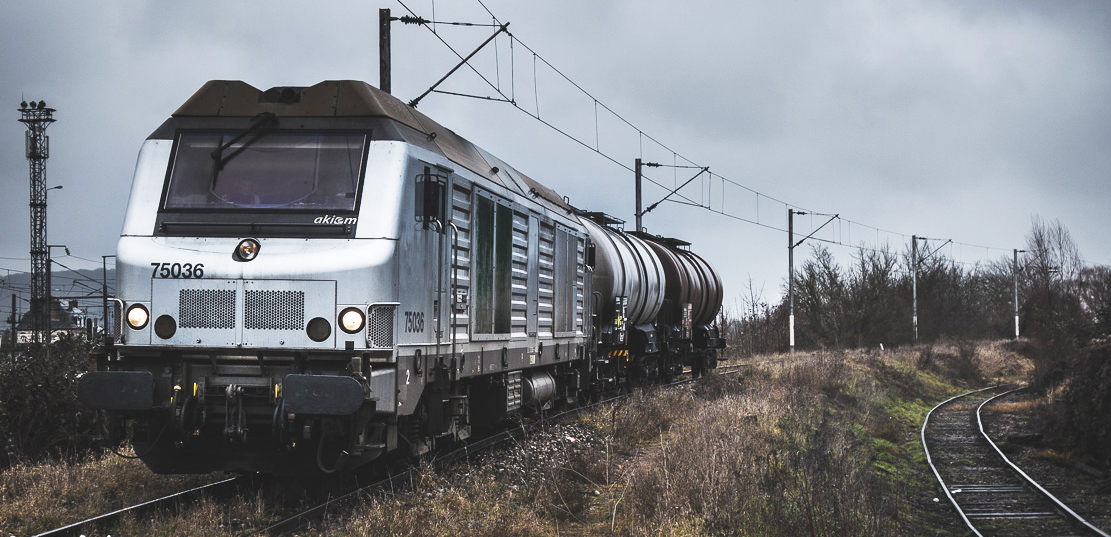 Train operator On Site Rail (now part of Belgium-based Lineas) handles tank wagons In the Compiègne area on their trip from Trosly-Breuil to Tergnier on 12 January 2017. © Quentin Douchet
Train operator On Site Rail (now part of Belgium-based Lineas) handles tank wagons In the Compiègne area on their trip from Trosly-Breuil to Tergnier on 12 January 2017. © Quentin Douchet
And the chemical industry wants to be green. All plants have rail service. For both domestic French and international movements, about 30% of Solvay’s rail traffic is wagonload. But the company also runs some unit trains. Reliance on rail is a problem in France given the threat of strikes, the small batches of a large variety of chemicals that Solvay ships, and inventory levels that Solvay keeps low to both save money and enhance safety. If transport stops, production often stops within a week.
Transit-time reliability
Yves-Marie Laurent, supply chain director of Vivescia, said that the French grain industry ships 50 million tonnes grain per year, of which 3-5 million move by train. His own firm sometimes moves 3000 tonnes per day during harvests. In the region of Troyes, east of Paris, they organised 34 trains for a summer harvest campaign. None of them ran as planned. But silos had to be emptied to make room for newly harvested grain. Olivier Deprez of AFRA and Lineas added that that the locomotive had to make a 150 km trip without wagons from its base to reach each train.
Mr Boeuf of Solvay said that as a shipper of chemicals, he is interested in transit time reliability for the whole journey of an international chemical shipment, not just to one country’s border. Longer transit times on rail than by truck are okay, provided they are reliable.
French public policy
In response to the stagnation of French rail freight, the French government is leading development of national strategies for logistics and rail freight. Another aspect of French public policy with a massive effect on rail freight in late 2019 was the government’s proposed reform of retirement and pension rules and the resulting strikes.
National logistics strategy
Within the French environment ministry, the division of infrastructure, transport and the sea (DGITM) is responsible for rail freight policy. Alexis Degouy of TLF said that the DGTIM is now working on a national strategy or master plan for logistics like those of the Netherlands and Germany. Contributors include French regions and private actors, who form a “sounding board”. The “France Logistic” strategy should emerge at the end of 2019 or start of 2020. It will bring forth the ideas now “waiting in drawers” and feed an inter-ministerial logistics committee.
A diesel and hoppers of train operator Colas Rail crossing the Loire River on Montlouis viaduct, just east of Saint-Pierre-des-Corps, on 12 April 2019. © Christopher L.N
Mr Degouy presented the contribution to “France Logistic” that Eric Hémar, president of TLF and of ID Logistics, was to address to environment minister Élisabeth Borne. The report argues for more competitive French logistic chains in the service of companies and of sustainable development. The World Bank places France’s logistics at rank 16 within Europe; Germany and the Netherland “monopolise” the top places. The “France Logistic” report traces a fictive but typical case of goods arriving from China at Rotterdam and undergoing logistic processing at Tilburg. France is not the heart, but rather an extremity of Europe analogous to the western tip of Brittany vis-à-vis the rest of France. Transport in France is too slow, too costly, is insufficiently massified and has thus lost its competitivity. Rail must win more than its current 9% share of goods. Rail service to and from French ports is critial. Logistics accounts for some 12% of firms’ costs. If France can’t organise massified solutions, businesses will go elsewhere.
Rail freight development strategy
French MP Jean-Marc Zulési told the audience that “you have before you a member of parliament who believes in the train”. The French parliament had passed a major “orientation law on mobility” the day before the Levallois conference, on 19 November. With the help of the association Objectif OFP, Mr Zulési said, he added a development strategy for rail freight, which had been absent. Article 178 (formerly 51) stipulates that France will define a strategy for the development of rail freight aiming to:
- Establish support mechanisms for modal shift and the development of combined transport in accordance with EU rules on state aid.
- Develop a rail component in the supply logistics for metropolitan areas.
- Modernise and mutualise infrastructures in French regions, particularly “capillary” feeder lines, support tracks, local access tracks and freight terminals.
- Develop infrastructure and exchange points for multimodal freight.
- Reinforce rail freight service to French ports and their hinterland.
- Develop “transnational” [and thus international] rail freight corridors.
The strategy is to include a quantitative evaluation of rail freight and current services and fix an objective for improving rail freight’s modal share on the time horizon of France’s low-carbon strategy. To develop and grow rail freight, it will prioritise areas, rail networks and especially infrastructure projects. The French government is to submit the strategy to parliament by the end of 2020.
Both Pascal Boeuf of Solvay and Julien Matabon, assistant director for rail transport at DGITM, hoped the sector can go beyond yet another report. Alexis Degouy of TLF emphasised the need for concrete results in the short term and not just in 10 or 15 years.
Rail’s pros and cons – and public perceptions
Jacques Chauvineau of Objectif OFP reminded attendees of rail’s lower energy use compared to truck, which he said is less mentioned these days. Jean-Pierre Orus of SNCF Réseau noted the challenge of making trains quieter while nevertheless keeping them moving. He also noted that the public worries more about dangerous goods on trains, where they are safer, than on trucks, where they are less safe.
Labour relations within the railway sector
Executive director Claude Faucher of UTP addressed the then-upcoming strike in the railway and a number of other public and quasi-public sectors in response to the French government’s proposed plans to reform pension rules.
Diesel locomotives of train operators Fret SNCF and VFLI – a separate subsidiary of the SNCF group – at the plant of auto maker PSA in Saint-Jacques-de-la-Lande just south of Rennes on 11 April 2018. Fret SNCF was handling wagons of auto parts, VFLI wagons of new automobiles. © Christopher L.N
[GR: The strike would start on 5 December and taper off – at least temporarily – in late January. A minority of France’s 125,000 railway employees, belonging to different unions, were involved. In France, each union adopts its own position in labour disputes: some are described as moderate, others as radical. As the strike proceeded, the number of rail strikers and cancelled trains gradually fell. But the strike may flare up again – especially in non-rail sectors with less strikers until now – as the pension reform law moves through the legislative process.]
Another issue is the general labour agreement for the railway sector, of which parts have been subject to discussion since 2014 that yielded agreements in specific areas along the way. The agreement covers pay, employee classification and union law. Mr Faucher said that reaching an agreement meeting the needs of big, medium-sized and small French trains operators has taken a long time. He said called the agreement favourable compared to those in other sectors.
French rail infrastructure
Speakers addressed the slow solution of problems associated with rail infrastructure in France, including the need to examine the network as a whole instead of as disjoint pieces, better support from SNCF Réseau, and slow improvements of clearances, train-length limits, path tolls, path planning and of secondary trackage, including capillary lines.
Regional vs. societal focus
Mr Chauvineau of Objectif OFP said that biggest and most important challenge is getting French regions to take back the initiative for freight. They are afraid that they will be the only ones to pay. New ways of addressing regional issues are shaking up habits formed during of decades of decline. Several regions are now creating logistic clusters. Examples are the Aquitaine region, including its new combined transport terminal in Niort, and the Centre-Val de Loire region. [GR: Another example is the Occitanie region, including the terminals around Perpignan.] The current French prime minister, who previously was the mayor of Le Havre, should not just consider the port and its economic success, Mr Chauvineau said, but instead consider the larger needs of French society.
Pascal Boeuf of Solvay said actors have to go beyond the costs and revenues of individual parts of the French rail network and see the whole picture including service to the public and sustainability.
SNCF Réseau
Arnaud Sohier, SNCF Réseau’s commercial director, said that his company’s new Rail Freight Platform (PFF) is bringing together stakeholders including the French combined transport association GNTC, AFRA [see below], Objectif OFP [see below] and ports [see above] to coordinate efforts and speak with a unified voice vis-à-vis public agencies that fund infrastructure. The PFF started in January 2019 and will show first results in the first half of 2020. Mr Sohier emphasised the need for collective work of all stakeholders. Investment has been chronically lacking, and this is a key. The PFF will have two time horizons: short-term issues and 15 to 30 years.
Two Fret SNCF diesels lead a stone train through Lyon’s Confluence district on 8 November 2019. The wagons had been loaded at the Bonnefoy Béton quarry in Courzieu, 30 km to the west. The train was then assembled in the small yard at Lafarge’s La Patte quarry just west of Courzieu before running northeast to Saint-Germain-au-Mont-d’Or then south via Lyon to Chasse-sur-Rhône. © Alexis Bonnet
Mr Chauvineau called the PFF a very good thing. SNCF Réseau now wants to densify the use of the rail network instead of cutting off branches it did as a few years ago. Alexis Vuillemin, DGITM’s director for transport services, said the French government will sign contacts on infrastructure performance improvements with SNCF Réseau.
Journalist Laurent Charlier of La Lettre Ferroviaire asked Arnaud Sohier whether SNCF Réseau could create an exchange platform for rail freight shipments. “We already have lots of projects,” said Mr Sohier, “but why not”.
P400 clearance standard for rolling stock
Gottfried Eymer of Euro Cargo Rail called the P400 clearances (or loading gauge) for rolling stock a standard in Europe. P400 allows the transport of truck trailers 4 metres high at the corners on normal pocket wagons. International shippers object to P400 gaps in France that exist nowhere else, he said. Just six tunnels 300 to 2700 metres long on the Metz – Strasbourg – Saint-Louis are smaller than P400. The result is a vicious circle of low traffic and low tunnels.
A simple solution, Mr Eymer said, is to remove ballast in the tunnels to gain the few centimetres lacking for P400. This only costs €1-2 million per kilometre. He said that SNCF Réseau needs to work with train operators to determine on what French routes P400 should be implemented soonest, for the most benefit at lowest cost. France also needs a mid- and long-term plan for P400.
Arnaud Sohier of SNCF Réseau said that P400 in fact admits trailers up to 4.10 meters high. Certifying that a route is P400 compliant requires checking all wires, structures and station platforms. [GR: It also requires ongoing checks that track or other work hasn’t re-reduced clearances.]
Are Lohr services braking P400?
One solution for P400 gaps on French routes lies in wagons from the French maker Lohr. The Lohr wagon’s floor pivots horizontally about 30 degrees to let a road tractor pull a trailer onto the wagon. The wagon’s floor then pivots back to travel position and lowers itself a few centimetres. This lets the Lohr wagon transport a 4-metre-high trailer on key French rail routes that lack P400 clearances. Also, by allowing trailers to roll on and off, the Lohr wagon is open to the 96% of European truck trailers that lack the specific reinforcement that allows a crane to vertically load the trailer onto a wagon.
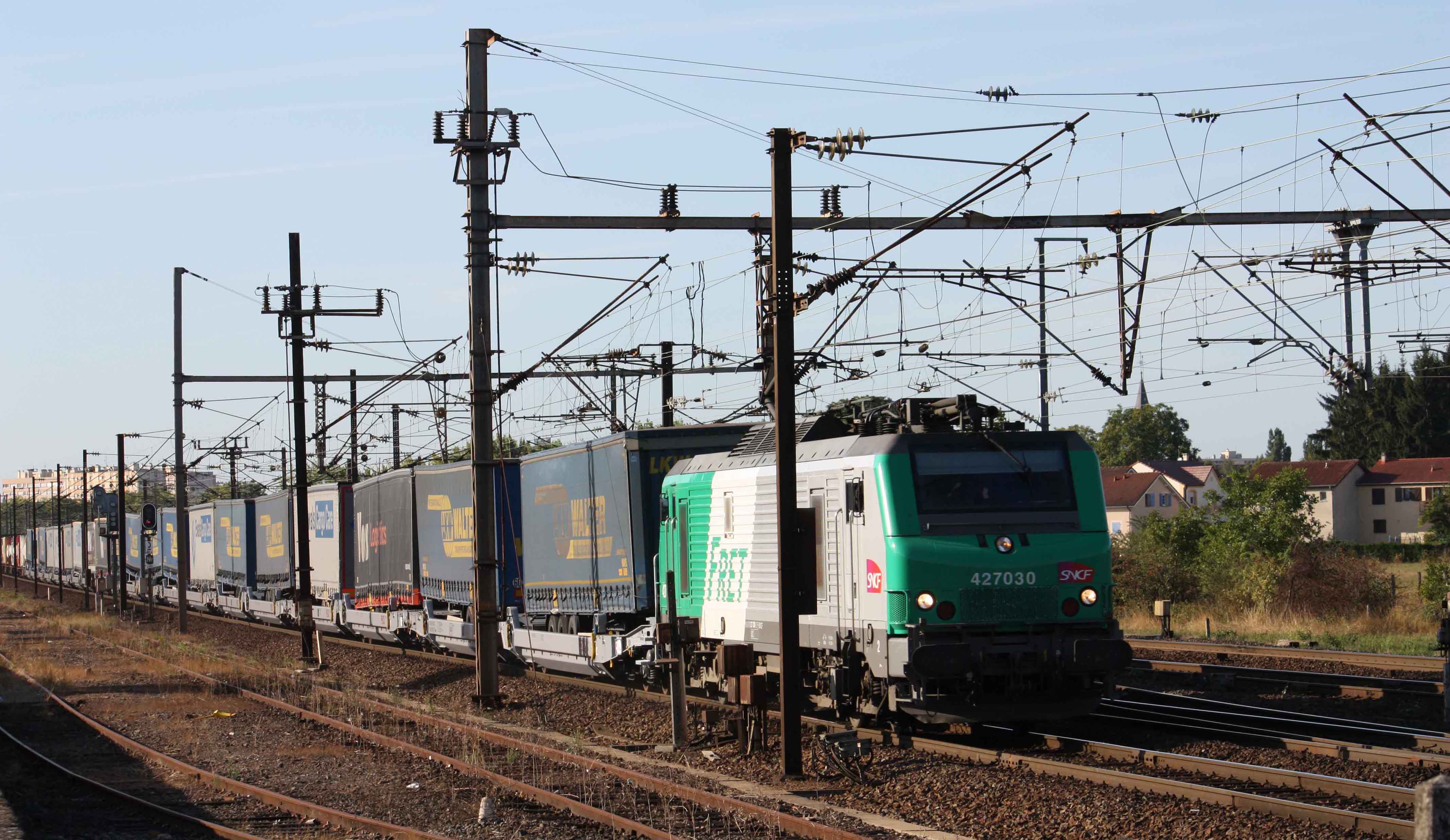 VIIA train of Lohr wagons at Woippy, near Metz, on a run between Calais and Le Boulou, near Perpignan, on 26 August 2015. © Lohr
VIIA train of Lohr wagons at Woippy, near Metz, on a run between Calais and Le Boulou, near Perpignan, on 26 August 2015. © Lohr
This openness comes at a price, however: the Lohr wagons requires elaborate, in-ground terminal infrastructure and the wagons themselves are more complex and costly than normal pocket wagons. [See the Railweb Report on Lohr wagons.] Mr Eymer of Euro Cargo Rail said that a Lohr wagon costs €132 a day, whereas a normal wagon for vertical trailer loading costs €55.
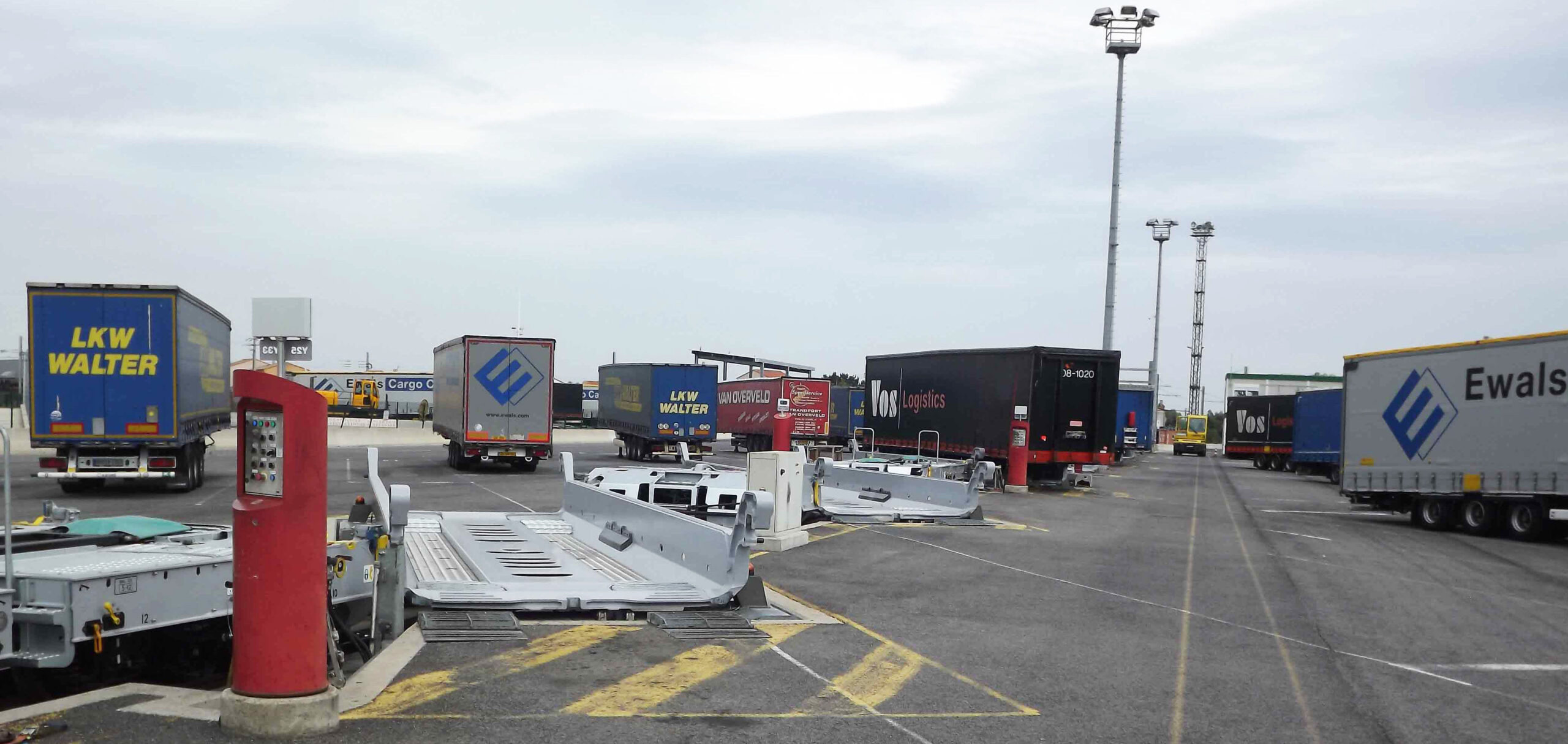 Diagonal parking of trailers and Lohr wagons, their cradles ready for loading, at the terminal in Le Boulou on 13 September 2015. The red stand displays the correct cradle height (low, medium or high) on the basis of the trailer’s weight as it entered the terminal. @ Lohr photo
Diagonal parking of trailers and Lohr wagons, their cradles ready for loading, at the terminal in Le Boulou on 13 September 2015. The red stand displays the correct cradle height (low, medium or high) on the basis of the trailer’s weight as it entered the terminal. @ Lohr photo
Today, only SNCF group subsidiary and intermodal operator VIIA operates Lohr wagons in France. Mr Emyer said that French state subsidies of VIIA services are taking pressure off P400 development.
Sylvie Charles of SNCF Logistics said that P400 is not an absolute priority on all routes. She said that the only subsidies that VIIA services receive are Energy Savings Certificates for which all combined transport operations are eligible.
[GR: The discussion did not settle the debate over the existence of subsidies for VIIA. Like combined transport terminals in many countries, the construction of the terminals VIIA serves has indeed been subsidised. These terminals contain special infrastructure for Lohr wagons. Under European and French law, such terminals are open to all operators with compatible wagons. But only VIIA and its Lohr wagons use these terminals today.]
Train lengths
Julien Matabon of DGITM said that a major, ongoing innovation in France is the management of long trains on main routes. Arnaud Sohier of SNCF Réseau said that long trains need long passing sidings but also long tracks in terminals. He called the future of combined-transport terminals – and particularly the length of their tracks – a central issue. [GR: Although long trains are often split for placement on shorter terminal tracks, this hurts the terminal’s capacity and efficiency.]
Jean-Claude Brunier of the Open Modal group said that in 2000, he founded the TAB Rail Road trucking company and the combined transport operator T3M. Their trains run between terminals in the Paris area (Valenton, Bonneuil), Lille and Nancy in the northern half of France and five points in southern France and Novara, Italy.
[GR: Originally, only train operating companies (railway undertakings or RUs) could request paths from national rail infrastructure operators in Europe. As part of the liberalisation of the rail freight market, the EU changed the rules to allow customers of RUs to buy a path without first selecting an RU.] Mr Brunier said that T3M was the first “authorised candidate” in France to buy its path directly from the French rail infrastructure manager.
Projects to allow long trains started in 2010 under Nathalie Kosciusko-Morizet, who headed the French ministry that at the time covered the environment, sustainable development, transport and housing. A first step was the operation of 750-metre trains in the Rhône Valley. This boosted productivity by 5-10%, Mr Brunier said.
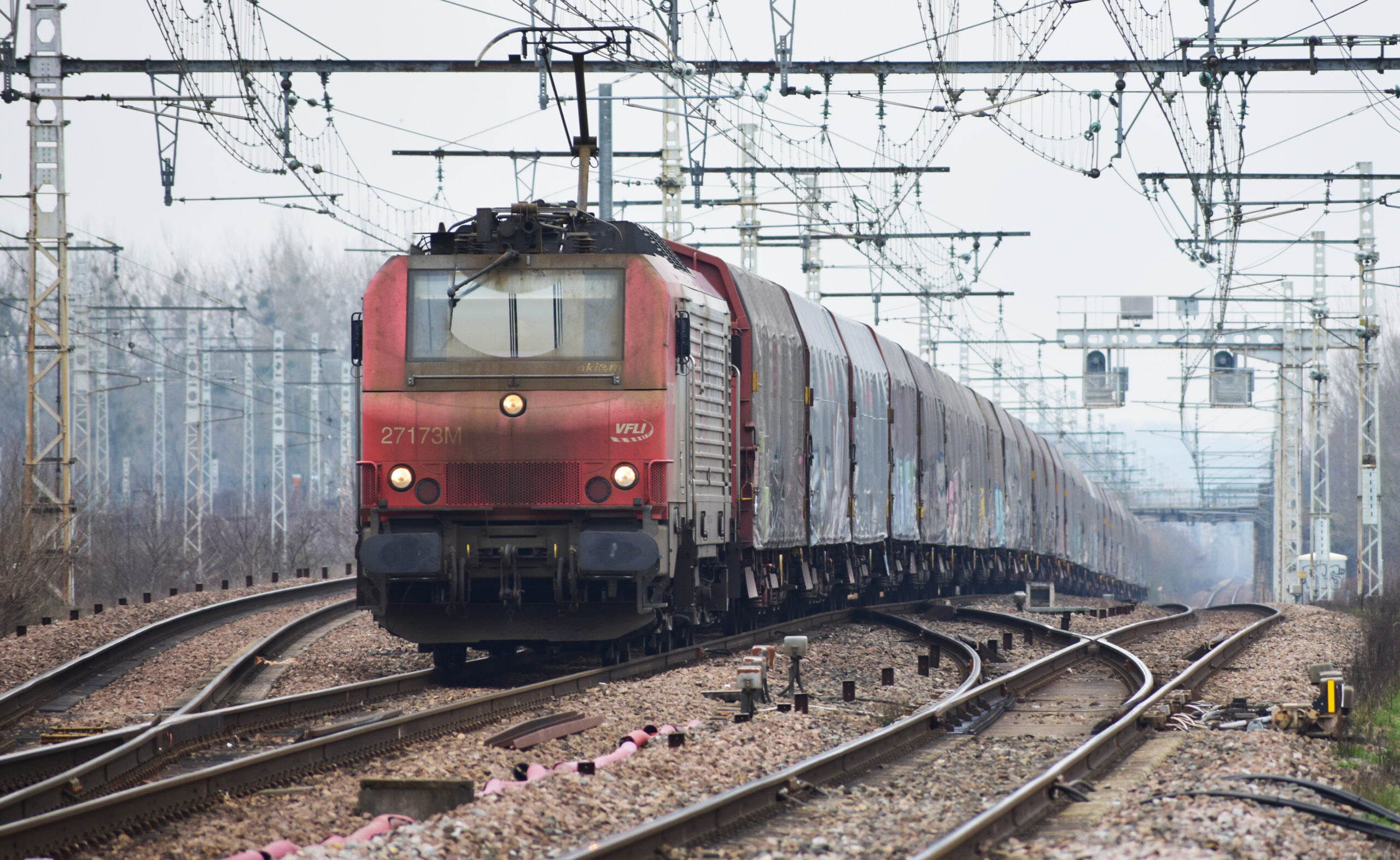 An electric locomotive of SNCF group subsidiary VFLI pulls a train of well under 750 metres at Bichain, east of Fontainebleau, on 5 February 2018. © Jonathan Guiho
An electric locomotive of SNCF group subsidiary VFLI pulls a train of well under 750 metres at Bichain, east of Fontainebleau, on 5 February 2018. © Jonathan Guiho
The next goal was 850-metre trains. This involved moving the turnouts, changes to both signalling and wagons, a new braking procedure and lower speeds. [GR: Longer trains can thus lower line capacity.] The main routes between northern and southeast France are now good for 850 metres, Mr Brunier said. Operators want the same capacity from the north to southwest France, i.e. to Bordeaux and beyond.
Long trains are particularly relevant for the shuttle trains of combined transport and less for conventional rail freight. [GR: Whereas for a shuttle service, only the wagons used in the shuttle need changes for 850 metres, services that accept different wagons every day, such as wagonload, would require changes to all wagons.] Mr Brunier also said that loaded containers on intra-European trips tend to be lighter than loaded maritime containers. [GR: A train of maritime containers is thus more likely exceed train weight limits before reaching 850 metres.]
Jean-Pierre Orus of SNCF Réseau said that 850-metre trains are now possible on the Liile – Luxembourg – Dijon – Lyon – Marseille/Perpignan, the Paris – Dijon and Paris – Le Havre routes. SNCF Réseau is now extending 850-metre capacity from Lille to Calais and Dunkirk and in 2020 will start studying Paris – Bordeaux – Hendaye. His company tries to modify signals and passing sidings to allow 850-metre trains as part of renewals being done anyway. Six 850-metre train pairs a day are now possible between intermodal terminals in the northern and southern halves of France. But SNCF Réseau has requests for other routes.
Mr Brunier pointed out that the availability of a path did not mean that every train using it is 850 metres. Philippe Guillard of the port of La Rochelle said that longer trains lets you limit the number of trains in urban zones around ports. But Mickael Le Ray of Total warned that 850 metres may not be the optimal length of all trains for shippers.
Capillary lines and access tracks
This was not the first conference to address the critical importance of the “last mile”, the movement of trains and wagons on secondary lines and tracks at the start or end of their main-line journey. France calls secondary rail lines with low traffic capillaries.
Mr Boeuf of Solvay said that capillaries are much more complicated than corridors. Problems in the last mile often kill plans for much longer trips.
Mr Laurent of Vivescia cited a case in which SNCF Réseau temporarily shut down a capillary during a heat wave, blocking a customer just 1 km from the main line. Another example was a train 4 km from the main network on a capillary whose safety rules prevented the train from moving because another train was 80 km away, at the end of the capillary. He saw a need to eliminate dogmas and take small actions that will bring big benefits.
Fret SNCF diesels arrive from Rosporden, east of Quimper in Brittany, at the nearby Coat-Conq industrial zone with grain hoppers on 27 August 2019. © Anthony Querleau
Hermann Schneider of Transdev asked why the conference was talking so little about mass distribution. Part of the answer came from Jean-François Lagane, rail logistics director of Nestlé Waters: Many French distribution centres removed rail sidings to make more room for trucks.
Julien Matabon of DGITM said that the French government has budgeted €20 million a year over the next five years for access tracks (voies de service). He also said that available government aid for local shunting tracks (installations terminal embranchées) is little used.
His DGITM colleague Alexis Vuillemin said that the France government is now seeking to rehabilitate capillaries – with and without passenger services – and access tracks that may not be “structurally relevant” for the national French network but that for local districts certainly are. Vivescia’s Yves-Marie Laurent said that a group of towns bought a line from SNCF Réseau for one euro, introduced new maintenance solutions for maintenance and are now moving 50,000 tonnes per year.
Paths
A central concern in rail freight is paths. Speakers addressed planning, tolls and quality.
Path planning
An ongong issue is the duration and instability of the path-planning process. Philippe Guillard said he starts collecting needs for paths between the port of La Rochelle and its hinterland three years in advance. Mr Brunier said that 850-metre paths must be a reserved a year in advance. Mr Eymer of Euro Cargo Rail complained that the timing of a path stabilises only two months in advance.
Path tolls
Mr Matabon of DGITM said that increases in SNCF Réseau’s track-access tolls are now limited to inflation. Mr Orus of SNCF Réseau said that lengthening a train from 750 to 850 metres increases SNCF Réseau’s toll proportionally but doesn’t push the train into a higher toll bracket. Pascal Boeuf of Solvay said that path charges shouldn’t depend on tonnage so as to encourage longer trains.
Yves-Marie Laurent of Vivescia said that his company agreed to pay SNCF Réseau a fixed toll charge equal to €2 per tonne per year. But this assumed a tonnage that changing weather and thus crop volumes don’t keep constant, so the price can swell to €6.
Path quality
Another issue, Mr Laurent said, is path quality: Paths don’t correspond to the operating hours of stations, whose hours can’t be changed. Mr Eymer of Euro Cargo Rail complained that on some routes, depending on what track works are in progress, each combined transport train requiring P400 clearances must obtain a special authorisation that may require it to traverse some sections at low speeds. This can delay trains up to a half a day, he said.
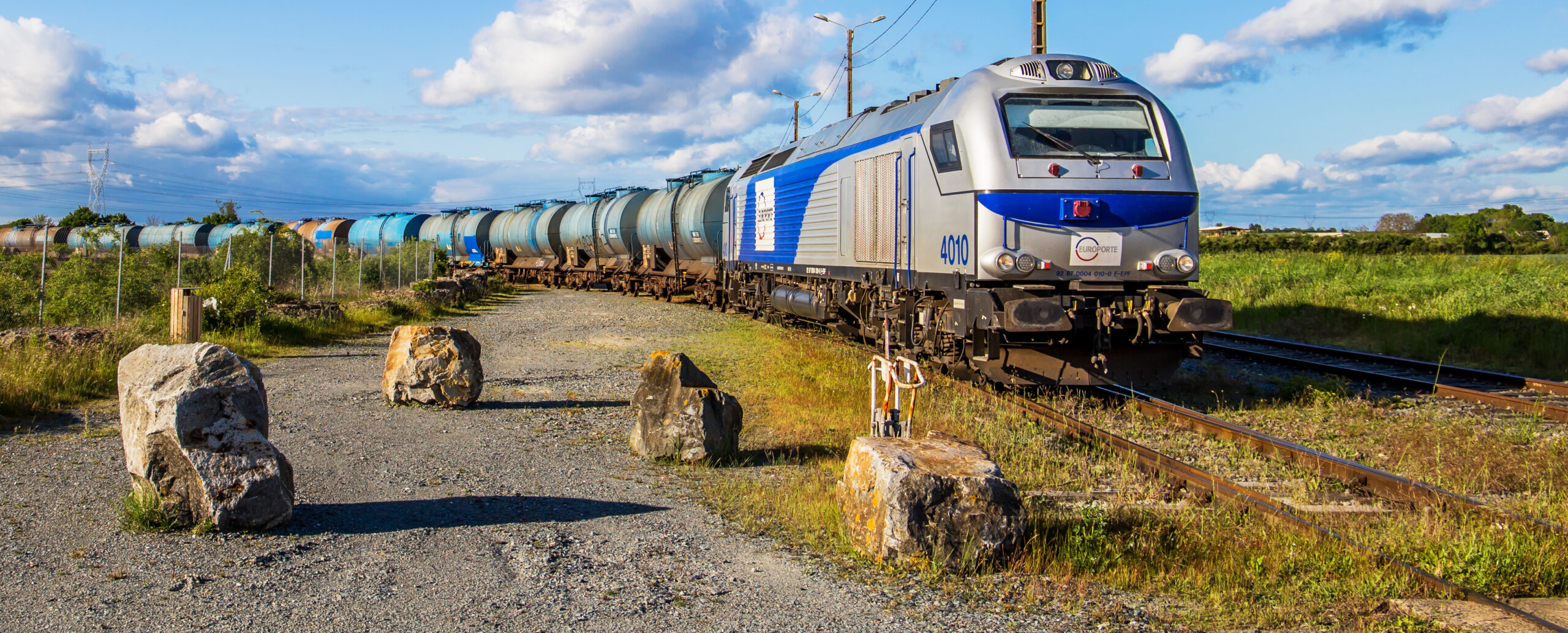 A Europorte diesel handles tanks of wine from Trèbes, east of Carcassonne, at Aiffres, just southeast of Niort, on 4 May 2019. © Anthony Querleau
A Europorte diesel handles tanks of wine from Trèbes, east of Carcassonne, at Aiffres, just southeast of Niort, on 4 May 2019. © Anthony Querleau
Train operating companies
Much of the conference focused on France’s train operating companies, which the EU calls railway undertakings or RUs. Next to the “historical” operator, Fret SNCF, about 20 other mid-sized and small RUs have entered the French rail freight market over the last decade. Olivier Deprez of AFRA and Lineas said in 2018, new entrants hauled 46% of French rail tonne-km.
Market opening
Mr Deprez said that the opening of French rail freight to competing train operators, which began in earnest about 2010, slowed the decline of rail freight’s market share and promoted service quality and innovation.
Fret SNCF
A legally mandated reorganisation of SNCF at the start of 2020 clarified the group’s structure. Within the SNCF Group, SNCF Logistics now encompasses freight and logistics activities worldwide. One subsidiary is Fret SNCF, France’s largest freight train operator. As of 1 January 2020, Fret SNCF acquired an “independent legal personality”, i.e. become a company owned by the SNCF group that operates with financial independence as a separate company.
The same will be true of other rail-freight holdings of the SNCF Group, including:
- Train operators VFLI (whose services emphasise last-mile components) and Captrain (which operates in European countries outside France).
- Freight forwarder Forwardis, which organises rail and other transport within Europe and to/from Asia.
- Combined transport operators Naviland Cargo (which hauls maritime containers to and from ports) and VIIA (which hauls truck trailers on the special roll-on, roll-off Lohr wagons).
Sylvie Charles is general director of SNCF Logistics for rail and multimodal transport. She said that Fret SNCF has had separate accounts since the 1990s and its own drivers since 2018. As an independent holding of the SNCF Group, Ms Charles said, Fret SNCF will have its own safety certificate as a train operator, meaning it can do more for the customer, for example operating into other countries if the French-speaking driver is accompanied by a local. Its new independence will also allow Fret SNCF to optimise its structures. It will thus re-internalise five rolling-stock maintenance centres that it had spun off. Alain Llor said at the conference that VFLI is doing the same.
French Rail Association (AFRA)
The association AFRA gives a common voice to the train operators who are France’s new rail freight entrants.
AFRA’s website says it supports companies that seek to enter the French market and promotes rail transport “in a context of regulated competition”. Olivier Deprez said that AFRA, founded in 2000, helps companies access the French rail network and deal with public agencies. AFRA held its annual conference on 7 November 2019. The group has both freight and passenger committees. Mr Deprez said that AFRA’s 16 members have 275 locomotives and have created 1900 jobs. Working groups for freight include access tracks, P400 clearance, network access, and a French subsidy known as “crane pickup help” or aide à la pince for each loading unit moving in combined-transport services.
Local rail operators
Since its first edition in 2011, a central focus of the annual rail freight conference in Levallois has been the local freight operator (opérateur ferroviaire de proximité or OFP). French MP Jean-Marc Zulési pointed out that he represents a district near Marseille, which is home to RTD13, an OFP of long standing that works with the port.
Marseille-area local operator RDT13 rolls empty gas tanks from Miramas to Martigues at Port-de-Bouc on the morning of 30 December 2019. © Elise V
Pascal Boeuf of Solvay said that on capillary lines and large installations such as ports, the French authorities should continue to delegate to OFPs the responsibility to provide a public service by taking over the operation of both infrastructure and trains. Alexis Vuillemin of DGITM said that the French government now sees OFPs as just as important as combined transport.
Freight rail operations
Mr Chauvineau of Objectif OFP said that the French rail freight sector needs both private and public solutions to expand and modernise. The conference addressed both.
Public support
Speakers examined the forms of public support for railways in Europe. Gottfried Eymer of Euro Cargo Rail said that Austria taxes trucks for their pollution and congestion and gives the proceeds to rail. In Scandinavia, he said, combined-transport trains pay no tolls.
Sylvie Charles of SNCF Logistics said the historical freight train operators in Austria, Switzerland and Belgium have survived only because of state aid for wagonload and combined transport. She noted that the Swiss Federal Office of Transport predicts freight and passenger traffic on the rails over the next 20 years in order to see bottlenecks and prioritise infrastructure projects.
Julien Matabon of DGITM saw public aid as appropriate for infrastructure, especially corridors and for ports. He said that at Antwerp, rail transport of containers benefits from subsidies that Le Havre doesn’t get. He said the French government intends to give more weight to rail freight vis-à-vis passenger service and track work.
DGITM’s Alexis Vuillemin said that the French government has now taken on a major project to develop strategies for logistics, ports (including hinterland transport) and rail freight. [See section on French public policy, above.] The government wants to schedule investments in “green and massified modes” such as rail and barge.
An audience member said that cost of fixing rail branches and closing rail electrification gaps would be 20 times less than building the Seine-Nord canal, but are less spectacular politically.
Wagonload service and combined transport
Mr Deprez of AFRA and Lineas says that searches for French rail freight in Google produce more hits for strikes and crisis than for modal shift. However, he said, rail freight has become an everyday subject – outsiders he talks with bring up rolling motorways and not strikes. Euro Cargo Rail’s Gottfried Eymer said that containerisation and “greenifying” were factors favourable to more intermodal transport in Europe.
On 7 February 2019, at Foëcy next to Vierzon in central France, a Fret SNCF diesel was pulling containers from St-Pierre-des-Corps to St-Germain-des-Fossés. The containers had originated at Longuefuye terminal, southwest of Le Mans. © Anthony Querleau
Mr Chauvineau of Objectif OFP said that 10% of rail freight is wagonload in France and 45% in Germany. Train operators must go find traffic in the French regions. One solution is combined transport, which also had lots of untapped potential.
Solvay’s Pascal Boeuf said that for chemical shippers, combined transport often doesn’t work. Some products are so dangerous that they cannot move by road at all. For other products, movement in tank containers and combined transport may be feasible when the terminal is less than 100 km from the chemical plant. This is often not the case. French combined-transport terminals are too few and far between. Wagonload is fragile, but chemical shippers have no choice.
From wagonload and unit trains to wagon blocks
Sylvie Charles of SNCF Logistics said that the trilogy of wagonload, wagon blocks (lots) and unit trains is finished. Many clients want to send blocks of wagons that do not fill a train’s capacity. A few years ago, Fret SNCF observed that when a shipper had a train to itself, on average it would use only 60% of the train’s capacity. Her company wanted to offer the remaining 40% to other shippers. For a time, Fret SNCF’s Opti-Fret product showed remaining capacity on trains 3 to 4 months in advance.
But the 60% was only an average. The volatility of shippers’ volumes has been increasing, even in steel production. Now Fret SNCF tries to assign block capacities to trains in advance. Some examples:
- They combined a block of heavy steel with a medium-weight block of automobiles, splitting each block between two trains.
- Between northern France and the Moselle département in eastern France, they sold a capacity block to a combined-transport operator that filled part of the train. This let the CT operator grow until it could commit to a train of its own.
- For a steel maker exporting via Dunkirk, they split a weekly unit train into two blocks per week. This required fewer wagons and less storage of wagons waiting for the departure of the unit train.
The problems of wagonload freight started in 1990s and came to head in the crisis of 2008, Ms Charles said. Offering the transport of wagon blocks lets Fret SNCF react faster.
Lineas in Belgium is using a related approach. Olivier Deprez said that the Belgian government subsidises combined transport from Antwerp. Green Xpress trains running from there to 15 industrial centres in Europe move wagons of both conventional and combined transport. Combined-transport wagons can run at 120-140 km/h, but the conventional wagons slow the train to 100 km/h. The train is thus slower, but financially viable because it is full.
Innovation in French rail freight
Journalist Émilie Soulez led a conference session that asked what technical, commercial and structural innovations can support rail infrastructure and operations. She said that innovations aren’t always new because of long implementation times. Mr Vuillemin of DGITM said that an innovation can be technical, but can also take the form of new local operators, changes in viewpoint and culture, and rules that allow more flexibility without affecting safety.
Smart wagons and trains
Wagon and train monitoring
Christophe Guionet of Traxens Rail presented applications of the internet of things (IoT) to objects in rail freight. CMA/CGM started Traxens in 2012; they work with SNCF and now have 6000 devices in wagons. The devices make wagons visible, he said. They help to track wagons, containers and other loading units door-to-door and to make maintenance and other decisions that save money. Their container devices also work on ships.
Deutsche Bahn subsidiary Euro Cargo Rail at Épinay-sous-Sénart, south of Villeneuve-Saint-Georges and Paris, on 22 September 2017. © Jonathan Guiho
A monitoring system automatically tests a train’s brakes. In this pilot system, which Traxens first presented at the Levallois conference in November 2017, devices communicate wirelessly with their counterparts in adjacent wagons to forward brake-test data to the locomotive. Although the system is still awaiting certification, it could eliminate the need for a person to walk along the train and check each wagon’s brakes and thus shorten the brake check from 45 to 15 minutes.
Philippe Guillard of the port of La Rochelle said that the Traxens solution to automate the brake check shortens the parking time of trains in urban zones. Mickael Le Ray of Total said that such on-wagon devices allow geo-fencing that shows who is responsible for an event affecting a wagon. But he said the reliability of devices and batteries is insufficient and can force field repairs. To enter sites handling flammable goods, which Europe calls Seveso sites, devices must also be certified as unable to spark fires.
Really smart wagons
An audience member announced a PhD project for self-driving wagons.
Energy sources
Jean-François Lagane of Nestlé Waters noted an increasing pressure for shippers to choose not just rail but the specific train operating company on basis of its CO2 emissions of its operations. Speakers addresses alternative energy sources for freight locomtives, including new fuels and bi-modal electric and diesel locomotives.
Train operator On Site Rail (now part of Belgium-based Lineas) in Hénin-Beaumont, south of Lille, on 11 April 2017. © Jonathan Guiho
Alternative fuels
Mr Lagane saw major innovations in the use of natural gas and hydrogen as locomotive fuels. An audience member pointed out that hydrogen is a way to store electricity and use it later as fuel. Gottfried Eymer of Euro Cargo Rail warned of innovations in other modes such as the electrification of truck routes.
Bi-modal electric and diesel locomotives
Mr Lagane also described his company’s work with the train operator (and SNCF group subsidiary) VFLI to launch a train between the Nestlé plant in Vittel in northeastern France and the port of Fos near Marseille. The train’s locomotive runs as an electric on line sections with catenary and as a diesel elsewhere. [GR: It is a Eurodual built in Spain by Swiss-based maker Stadler.] Alain Llor of VFLI said the locomotive cost them €6 million; the price depends on how many countries’ signalling systems the locomotive must handle. Olivier Deprez of AFRA and Lineas pointed out that VFLI, which is not a member of AFRA, is the only French train operator with a locomotive able to run as a diesel or electric. [GR: As this article’s photos show, even on electrified lines, diesels often power French freight trains for direct access to non-electrified last-mile trackage.]
Philippe Guillard said the innovation consortium at the port of La Rochelle is interested such bi-modal locomotives for both line running and shunting.
Trials in La Rochelle
Mr Guillard also said that a consortium for innovation has formed at the port of La Rochelle. The port’s private network will allow the test of innovations. He said that rail freight needs innovations in its infrastructure and organisation.
E-learning
Michel Cardinal, director of Colas Rail’s Rail Campus, presented digital solutions for teaching and implementing rail safety rules. Colas Rail trains people in the most common rail jobs. To make teaching more dynamic and effective, the company employs digital walls, quizzes, votes and brainstorming. They also offer realistic simulations. Their demands for realism lengthened the development of their train-driving simulator by nine months, he said.
A student can attend an e-learning lesson whenever and wherever the student wishes. This is more convenient for students – and their employers – than classroom teaching. It also allows students to take an e-learning course and (for example) learn basic vocabulary just before starting the same activity in the field. This contrasts with classroom training that may have occured months before.
The goal is not so much to save money compared to classroom training, but to be more efficient. Mr Cardinal called it “supervised self-training”.
One module educates the watch personnel who help coordinate track work and train traffic. The module is a “serious game” with different versions for day and night track work. In the course of a shift, the student must deal with various expected and unexpected track blockages whose probable durations the watchperson must determine and then report to the train dispatcher.
Another module evaluates a track work supervisor with 20 questions – chosen at random but representative – with suggestions for additional training. Colas Rail tests their e-learning modules with “pilot trainees”.
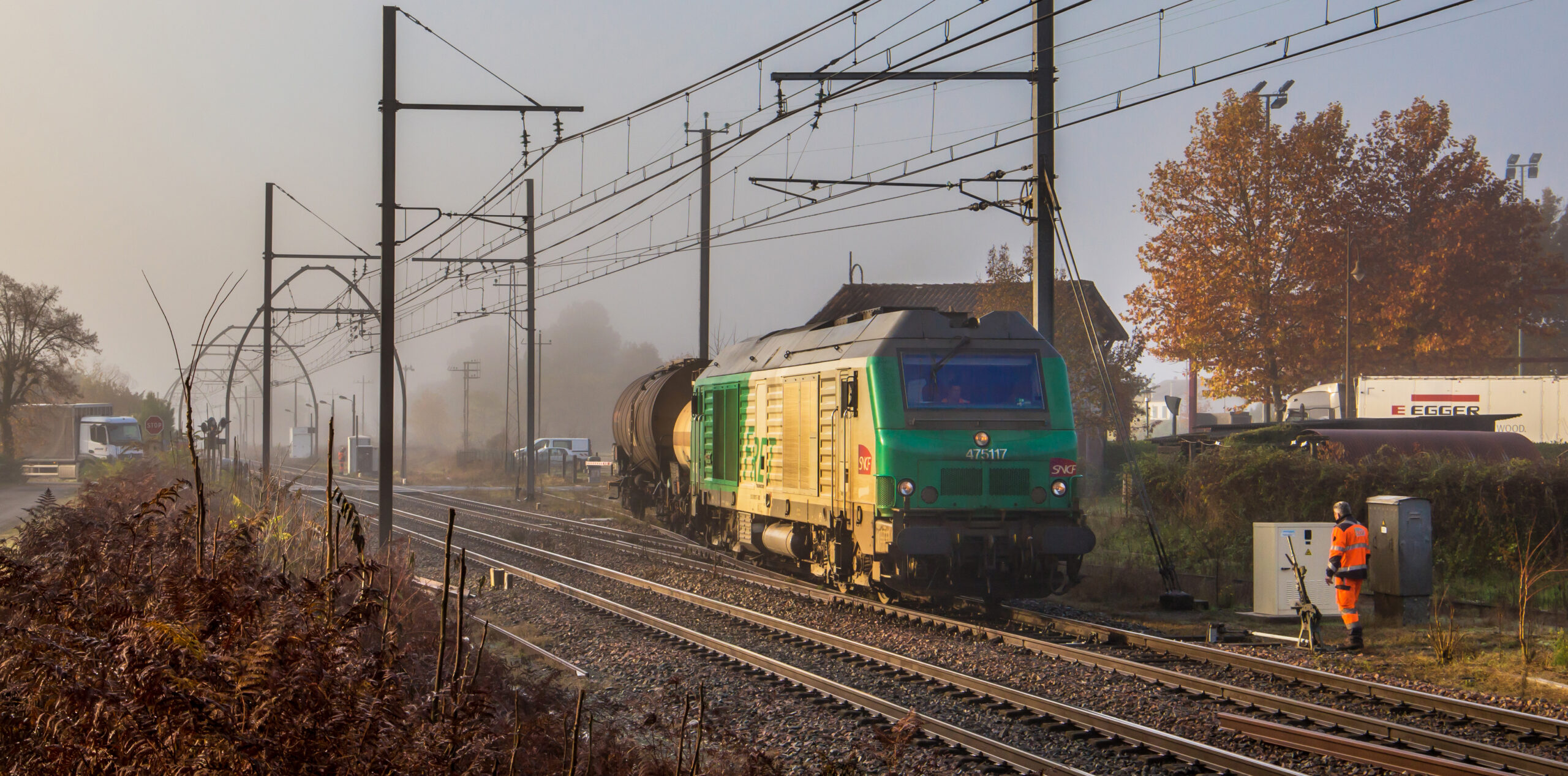 Having come south from Bordeaux, a Fret SNCF diesel shunts tank wagons at rubber ingredient maker MLPC in Rion-des-Landes on 15 November 2018. © Anthony Querleau
Having come south from Bordeaux, a Fret SNCF diesel shunts tank wagons at rubber ingredient maker MLPC in Rion-des-Landes on 15 November 2018. © Anthony Querleau
A company may need to train all its employees on changes in safety regulations. But getting them all together for a class is difficult. An e-learning module therefore translates the rule book into commented images that allow an employee to quickly understand changes in rules (for example for level crossings) and to remember them. When training many people in a short time, e-learning may prove both more efficient and cheaper than classroom instruction.
Re-inventing the flanged wheel
Jean-François Lagane of Nestlé Waters observed that “often, the piano is moved more than the stool”. Too many solutions are individual; companies need to be willing to use someone else’s proven solution instead of inventing their own. More cooperation is needed, even between companies that compete in other areas. [GR: In the railway sector, the same applies to countries, who can profit from their neighbours’ solutions if they consider them.]
George Raymond can be reached at graymond@railweb.ch.
© Copyright 2020 George Raymond. All rights reserved.
Back to Railweb Reports

